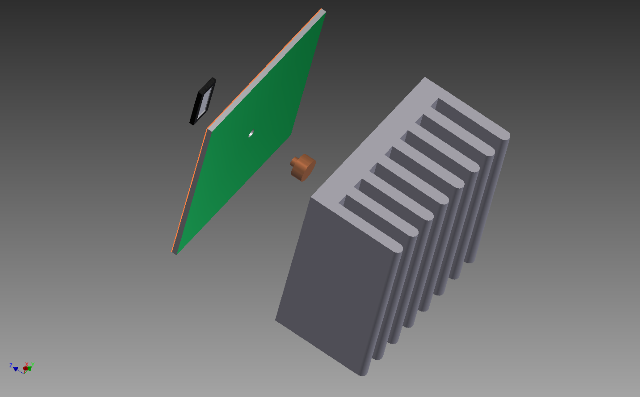You are a secret agent with the latest in gadgetry; superbly handy weapons and an array of fashionably handsome disguises. Your counterpart and nemesis, Doctor Mayhembert, the most insidious villain on the face of this planet, has decided to plunder our society with an obscure rationale which calls for immediate action. After jumping from your masterfully crafted and weapon loaded sporty car, you dodge a few bullets, capture the villain and save the day, all while “keeping it cool”.
OK, maybe you are not a secret agent, but it is still your responsibility to keep it cool. You are an electrical engineer tasked with a stepper driver design which will source so much current, heat is starting to become a problem. That’s your Doctor Mayhembert! How can you keep it cool?
Most integrated drivers out there will be packaged leaving a large metal pad exposed, which can then be used as a means to release heat out of the package and away from the die. For example, devices like the DRV8811, DRV8818, DRV8824/25 (just to name a few) are built into HTSSOP packages with an exposed PowerPAD at the bottom. This PowerPAD is soldered into a large copper structure in the board, with the intention of providing a path for heat to flow away from our Power Stage. In other words, the power stage’s PCB becomes its own heat sink.
When I design motor control modules, such as the AE-STPR8811 or the AE-MegaMotor, I basically flood the entire top and bottom layers with copper. These modules are two layer boards, 2 oz copper density, which is the best I can do to enhance the heat sinking effect for these modules.
Unfortunately, there is so much you can do with a copper fill and increased density to provide a meaningful heat sinking effect. In this type of implementation, as current approaches its rated maximum value, and the ambient temperature is much more than 25C, chances are the driver will not be able to sustain current output, with the thermal protection taking over shortly after. This means a rupture in the motor control operation and it is to be avoided at all costs!
The solution I see most people trying to employ is applying an air foil, epoxy glued to the top of the device in question. Allow me to tell you this is not going to work well at all. The plastic material in which the die is enclosed, has a poor thermal conductivity which means removing heat through this medium will be painfully slow, not to mention highly inefficient. The truth remains: the best way to release the heat out of the device is through the PowerPAD!
So what can we do?
A few months ago a young inventor from TEM Products Inc. sent me a sample of a recent inspiration he had decided to pursue. This idea is based on a copper cylinder, better known as a PowerPeg TM, which solders directly into the power stage’s PowerPAD through an opening at the bottom of the board. To the PowerPeg we bolt an air foil, which decreases the thermal impedance to impressive levels. Figure 1 shows a concept drawing of how to attach the PowerPeg and respective air foil into a PowerPAD based device and board.

Figure 1: PowerPAD based device meets its savior, the PowerPeg based air foil.
To give you an idea of the improvements associated with this novel method of interfacing a heat sink into the PowerPAD, I took one of my modules and redesigned it to accept the peg and the air foil. The result was the AE-STPR8818-TP, which remains a small sized module capable of supplying even more than rated current at the same time it remains cooler. Did I say more than rated current? Did I say it actually runs cooler? I guess we will need to take a look at some numbers to make some sense into that last statement.
The DRV8818 is rated at 2.5A but its Over Current Protection is actually set at 3.25A. The device is rated at 2.5A because with conventional copper flooding techniques this is pretty much all you can do. In this case, running the motor at 2.5A and ambient temperature at 25C (VM = 24V, 8 degrees of microstepping, Step Rate = 1000 Steps Per Second, Mixed Decay, 1.4 us TBLANK, 47 us TOFF, etc.), will give you a case temperature of about 90-100C. Increase the current to 3A, and you are now dealing with temperatures soaring into 120-130C. If the ambient temperature was 50C, a rather typical scenario, the device would be nearing its temperature protection set point, jeopardizing motion control integrity.
With the heat sink, however, we get a completely different thermal picture. Even at 3A, the device is not hotter than 50-60C. Figure 2 shows a thermal capture of the AE-STPR8818 (no PowerPeg based Heat Sink) and the AE-STPR8818-TP (with PowerPeg technology).

Figure 2: AE-STPR8818 (left) and AE-STPR8818-TP (right) thermal capture
In conclusion, the device will run cooler at 3A with the heat sink than it will run at 1.5A without it. Now if you ask me, that is some 007 worthy technology!
For more information on PowerPeg based modules, feel free to visit my web page at www.avayanelectronics.com. For more information on the PowerPeg heat sinking system, feel free to visit TEM Products website.